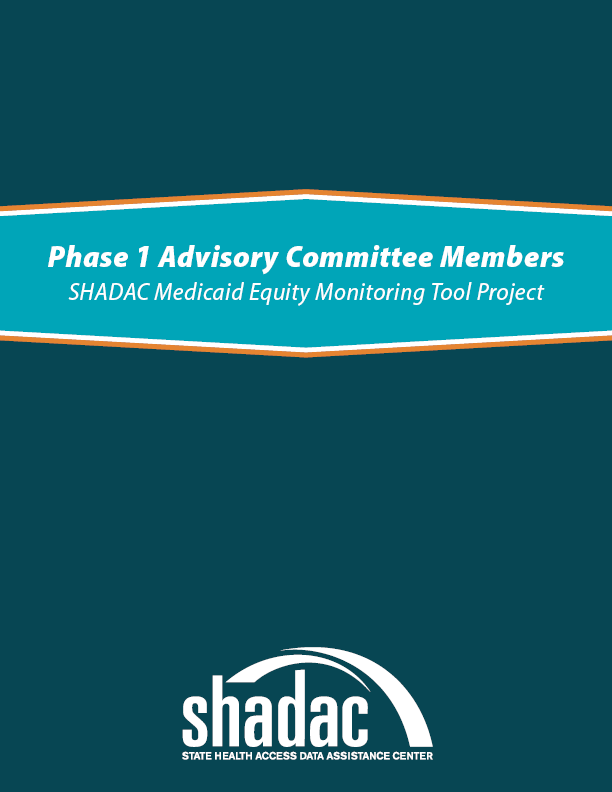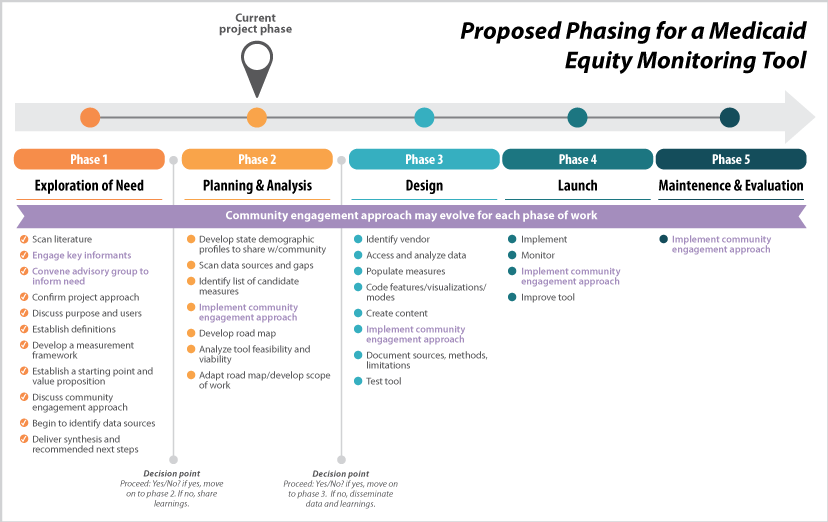Determining the Need for a Medicaid Equity Monitoring Tool
Project Overview
People who experience health inequities based on race, disability, sexual orientation, gender identity, immigration status, and other factors, are a longstanding and pervasive problem that is deeply rooted in discrimination and structural racism. The Medicaid program, through its policy, financial, and programmatic levers, is uniquely situated to address the health inequities experienced by the program’s diverse population of enrollees. Key to these efforts is the availability of comparable state programmatic and performance data to identify and track progress.

With support from the Robert Wood Johnson Foundation, the State Health Access Data Assistance Center (SHADAC) at the University of Minnesota School of Public Health is leading a multi-phased project to assess whether identifying a set of key equity-related indicators and populating them into a centralized “Medicaid Equity Monitoring Tool” could be a helpful, feasible, and reliable way of tracking and advancing health equity in Medicaid. The goal of a potential Medicaid equity data tool is not to replicate other state-level data dashboards or repositories, but to serve as an easily digestible, equity-focused, comparative data resource that could be used both as a monitoring tool to assess progress toward achieving health equity goals in Medicaid and as a catalyst for state-led health equity initiatives.
A future Medicaid Equity Monitoring Tool could be used to:
- Explore differences in access for certain populations of interest across states;
- Set goals and monitor progress;
- Learn from program actions in other states to advance health equity;
- Identify and address state technical assistance needs;
- Shape policy;
- Assess how federal action may affect states; and
- Facilitate conversations in communities about what’s working and what’s not, or where new data are needed.
Advisory Committee
At various stages over the year-long course of the project’s first phase, SHADAC hosted three virtual convenings of the Advisory Committee and held invited and ad hoc conversations with several key partners and informants to discuss a number of aspects, including a measurement framework for advancing health equity in Medicaid, priority measurement concepts and populations of interest, a prospective wireframe (a two-dimensional layout of a product designed to garner response on content and usability), and value proposition for a potential first-iteration tool.
Project Learnings
One of the first lessons that SHADAC project team members learned is that we needed to vastly slow down the pace of our project work in order to: 1) give fuller consideration to the upstream and root causes of inequities as we attempted to define a measurement framework and foundation of a Medicaid Equity Monitoring Tool, and 2) be able to respond to input from project partners in real time and to ensure that the voice of Medicaid community members would be centered in all efforts to conceptualize, design, and build such a tool.
While this project was always intended to span multiple years and multiple phases of work, SHADAC team members made concerted efforts to ensure that the scope of the work accounted for the purposeful involvement of and response to the recommendations and participation of a diversity of voices, including community members, individuals with lived experiences, health equity experts and scholars, data specialists, and other stakeholders.
Currently, the MET project is planned for five phases of work, with two crucial decision points on whether or not the tool could or should be built, as outlined to the right (click the image to enlarge).
Phase 1
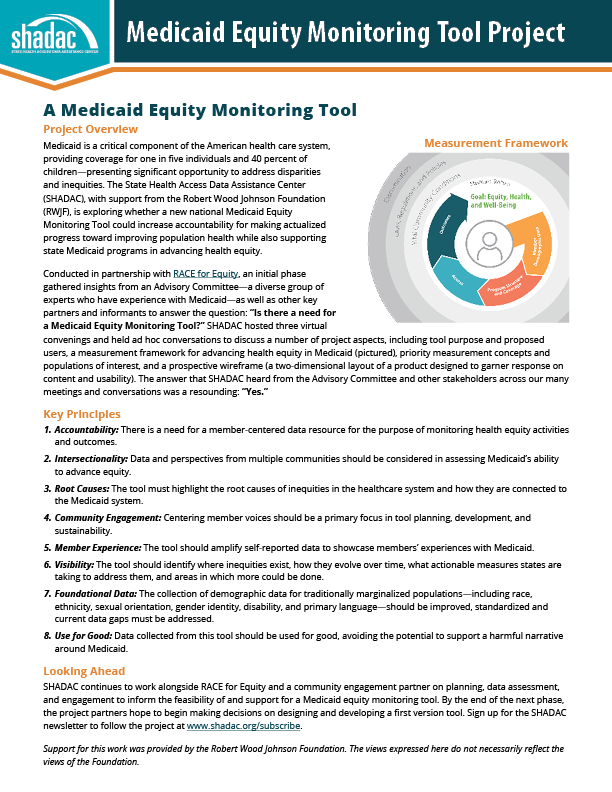 Between May 2021 and April 2022, SHADAC researchers consulted key informants, convened an advisory committee, and conducted reviews of selected literature to carry out the initial phase of this work. Our advisory committee consisted of a purposeful selection of individuals who bring diverse perspectives on the Medicaid program to guide the project and advise about whether and how a Medicaid Equity Monitoring Tool could be most useful and for whom.
Between May 2021 and April 2022, SHADAC researchers consulted key informants, convened an advisory committee, and conducted reviews of selected literature to carry out the initial phase of this work. Our advisory committee consisted of a purposeful selection of individuals who bring diverse perspectives on the Medicaid program to guide the project and advise about whether and how a Medicaid Equity Monitoring Tool could be most useful and for whom.
In preparation for and in concert with Advisory Committee meetings, SHADAC developed a measurement framework for advancing health equity in the Medicaid program with input from the advisory committee. The framework included both potential Medicaid health equity measurement concepts and possible data sources. Phase 1 project work concluded with a wireframe example of what content and features a potential tool could include as well as recommendations on the necessity of a Medicaid Equity Monitoring Tool and next steps in future phases of the project.
For a high-level overview and description of major project milestones, including formulation of project key principles, which will continue to direct our work and future project phases, see our Phase 1 summary to the right (click on image to enlarge).
Phase 1 Products
Linked below are a selection of products developed from the work performed in Phase 1 of the Medicaid Equity Monitoring Tool (MET) project.
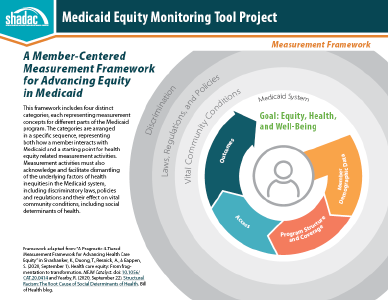
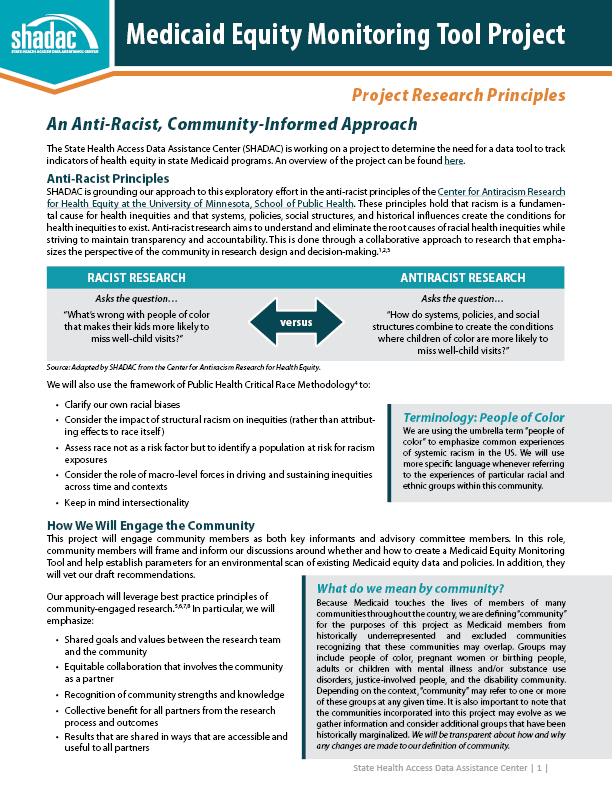 Research Principles
Research Principles
For a closer look at the research principles developed by SHADAC team members alongside our partner, RACE for Equity, that underpinned the approach to Phase 1 work, see our Anti-Racist Research Principles and Member-Centered Measurement Framework to the right (click on images to enlarge).
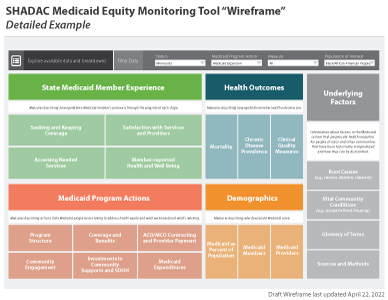
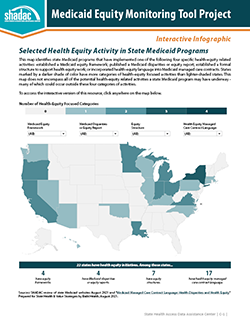 Data-related project work
Data-related project work
For a select highlight of data-related project work, such as a review of state-level health equity actions (as of August 2021) and a high-level conceptualization of a potential tool wireframe developed prior to the final Phase 1 Advisory Committee meeting in spring of 2022, see our materials to the right (click on images to enlarge).
Some of these products were created at a specific point in time and at a certain stage in our approach. As such, certain terminology, goals, or conceptualization of community engagement may have since been adjusted or reconsidered as our work has evolved.
Phase 2 (and Beyond)
While the work of Phase 2 is just beginning, SHADAC is currently in the midst of several exciting project developments.
Firstly, we are pleased to announce a new partnership with Health Leads, an organization with national reach that focuses on partnering with communities and health systems to discover and address societal and systemic causes of inequity that impact health and disease. Health Leads is leading the work to facilitate Medicaid member and community discussions around potential data measures that would be meaningful for inclusion within a potential tool, and ensuring that these voices remained centered throughout all project work and processes.
Secondly, SHADAC researchers have been concurrently working to understand what available data measures currently exist that could be useful in populating a Medicaid Equity Monitoring Tool. While there were many possible points of entry into beginning this work, ultimately we came to the conclusion that we needed to start somewhere, and made the decision to concentrate on one potential category area, or "domain" (i.e., colored box from the Tool Wireframe, see link above) – Medicaid Member Experience.
A variety of reasons went into the decision to start with this category, including takeaways from meetings with our Phase 1 Advisory committee, guiding project principles regarding our continued commitment to centering the experience of Medicaid community members, and SHADAC’s own prior experience and knowledge regarding survey data and availability of potential measures.
After a careful and attentive review process, SHADAC is pleased to share a pair of related new resources, the “State Medicaid Member Experience Quantitative Data Scan” and the companion “State Medicaid Member Experience Qualitative Data Scan.” Each of these resources highlights key sources (survey data in the former and research studies in the latter) that hold the greatest potential for measure population in this area, while also intentionally pointing to critical gaps in availability and existence of current, relevant sources and measures (including highlighting the lack of data stratification in surveys for key demographic groups and lack of longitudinal studies in qualitative research). SHADAC researchers also include several proposals for addressing quantitative gaps and absences, providing suggestions for improving current data collection efforts/programs as well as implementing new data collection methods.
We are also pleased to announce the release of the first section of an Annotated Bibliography that we hope will serve as an important resource for populating another category of the wireframe – Underlying Factors. The Annotated Bibliography compiles a curated and thorough list of academic research and grey literature sources that explain and provide analysis for the underlying factors and root causes that may contribute to inequities in Medicaid. These topics are complex and intersectional, and our researchers scanned for recent (2018 and onward) and relevant sources that would not only help readers understand the varied and interconnecting root causes of Medicaid inequities but would also identify and uplift potential solutions.
The Annotated Bibliography is currently structured into five separate but related sections: Systemic Racism; Systemic/Structural Ableism; Sexual Orientation, Gender Identity, and Gender Affirming Care Discrimination; Reproductive Oppression in Health Care; and Impact on Vital Community Conditions. We are first releasing the Structural Racism section, which is further organized into an ascending date order list of all sources with a summary and general findings included below each citation. Stay tuned for further section releases from the Annotated Bibliography in the coming months!
At the end of Phase 2, the project will reach another decision point, at which SHADAC will make a recommendation, in concert with our partners and community voices, to RWJF on the feasibility of moving forward into the final phases of building, operating, and maintaining a Medicaid Equity Monitoring Tool.
MET Project Phase 2 Resources
State Medicaid Member Experience Quantitative Data Scan |
|
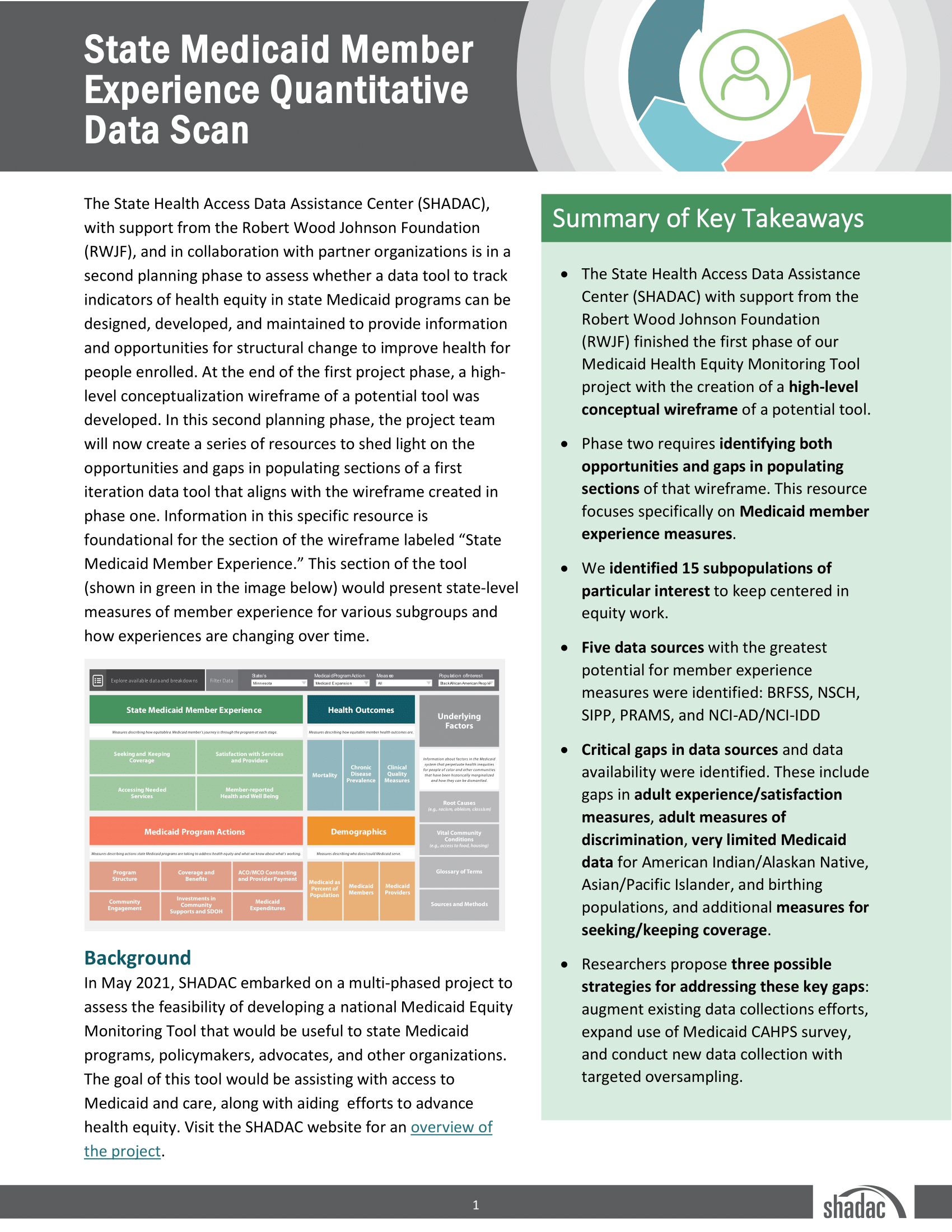 |
This resource highlights a number of key quantitative data sources that hold the greatest potential for measuring population in this area, including the Behavioral Risk Factor Surveillance System (BRFSS), the National Survey of Children’s Health (NSCH), the Survey of Income and Program Participation (SIPP), the Pregnancy Risk Assessment Monitoring System (PRAMS), and National Core Indicators – Aging and Disabilities and National Core Indicators – Intellectual and Developmental Disabilities (NCI-AD/NCI-IDD). Not only that, but this resource also points to critical gaps in availability and existence of data sources and data measures themselves, including highlighting the lack of data stratification for key demographic groups. |
State Medicaid Member Experience Qualitative Data Scan |
|
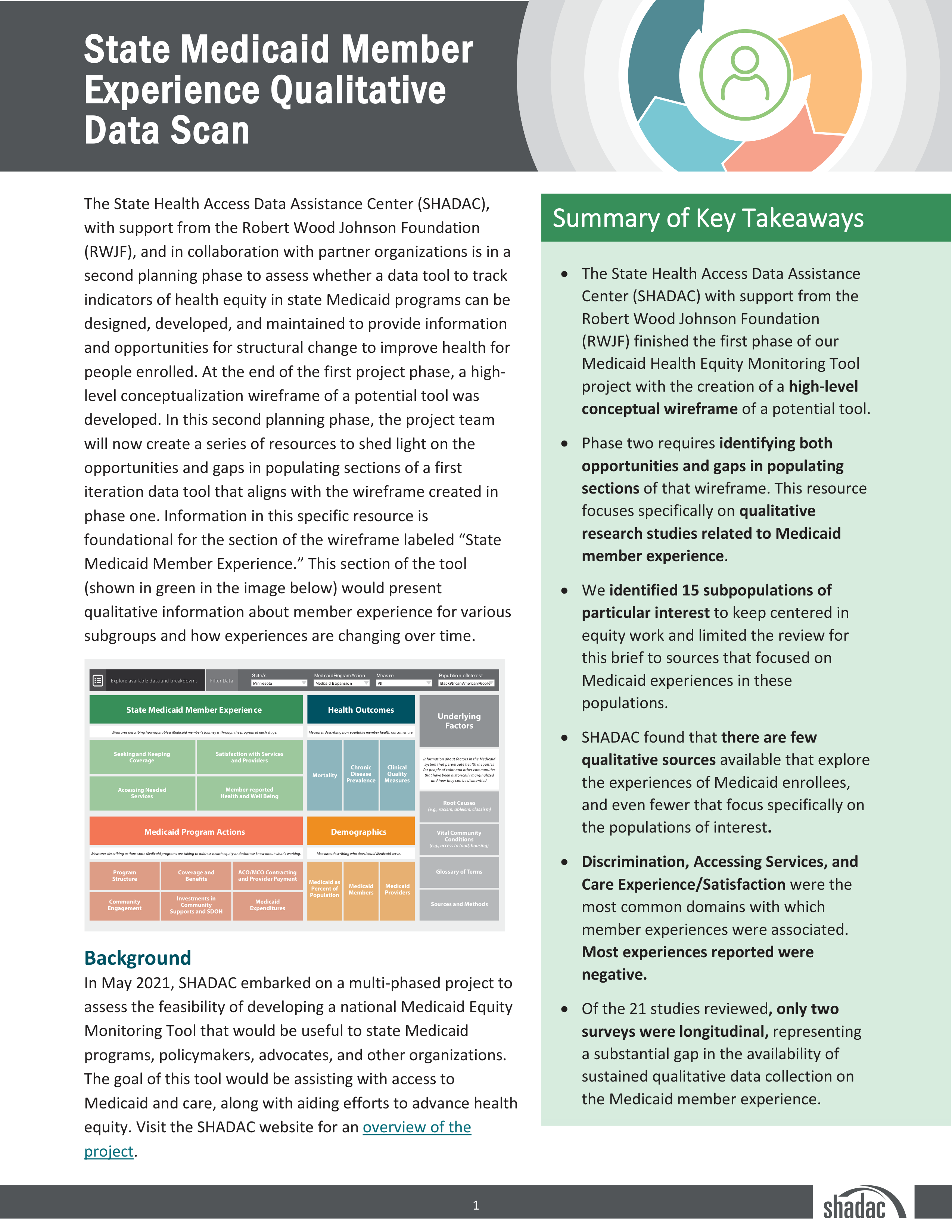 |
This resource examines the qualitative aspects of Member Experience through identification of related research studies. In addition to a summation of the scan results, the resource also contains an appendix table that crosswalks each source to all relevant measurement domains (e.g., Accessing Needed Services, Member-reported Health and Well Being, Satisfaction with Services and Providers, Seeking and Keeping Coverage, and Discrimination), provides relevant quotes from either Medicaid members themselves or their representatives, and includes population demographics such as race/ethnicity, disability status, and geographic location, among others. |
Underlying Factors of Medicaid Inequities Annotated Bibliography |
||
 |
The Annotated Bibliography compiles a curated and thorough list of academic research and grey literature sources that explain and provide analysis for the underlying factors and root causes that may contribute to inequities in Medicaid. These topics are complex and intersectional, and our researchers scanned for recent (2018 and onward) and relevant sources that would not only help readers understand the varied and interconnecting root causes of Medicaid inequities but would also identify and uplift potential solutions. The Annotated Bibliography is currently structured into five separate but related sections: Systemic Racism; Systemic/Structural Ableism; Sexual Orientation, Gender Identity, and Gender Affirming Care Discrimination; Reproductive Oppression in Health Care; and Impact on Vital Community Conditions. |
|
Underlying Factors of Medicaid Inequities: Conversations with Experts on Racism and Medicaid |
||
 |
As a follow-up to the creation of the annotated bibliography, SHADAC’s Health Equity Fellow held consulting conversations with authors of select resources cited in the structural racism section. Through these conversations, our goal was to:
This brief summarizes these conversations, including specific examples and quotes from experts, for audiences interested in communicating about the effects of structural racism with the aim to dismantle it. |
|
Contact Information
For questions, comments, or suggestions about the work of this project, please reach out to either of SHADAC’s Co-Principal Investigators, Dr. Lynn A. Blewett at blewe001@umn.edu, or Christina Worrall at cworrall@umn.edu.
Support for this project is provided by the




